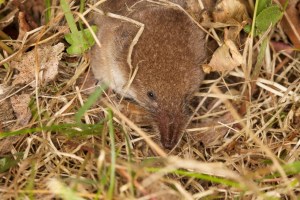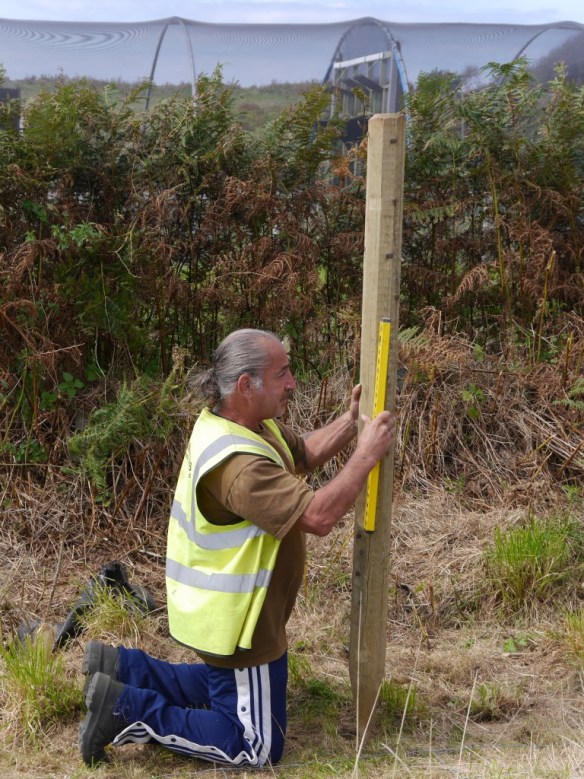 By Liz Corry
By Liz Corry
At the start of September the eight captive-reared chicks were released into Jersey. After their thirty-day quarantine and pre-release training they were finally ready to join the rest of the flock. As with the previous chicks released into Jersey we have named them alphabetically with a nod to their new home. We have four males and four females to introduce to the group. Kevin, named after Ronez’s site foreman who looked after Dusty in the quarry, Lee (Durrell), and (St) Mary are the eldest of the group, albeit only by a week or two. Noir, Ormer, and Pyrrho are three girls from the same clutch, and Q and Ronez are the youngest brothers. Each bird has its own colour ring and a radio transmitter attached to their tail feathers so we can monitor them closely after release.
 The method for this release had to be tweaked to account for the fact we had almost twice as many choughs living outside of the aviary. Attempting to call back and lock-in eight specific individuals from a group of twenty-three each night would be a practical nightmare (and most likely cause nervous breakdowns amongst staff). This time we simply let them out on the first night then planned to follow them like hawks, so to speak, and call them back for food as and when. We relied on the social intelligence of the choughs knowing that the outside group would act as mentors and, hopefully, ‘anchor’ the new birds to the aviary site.
The method for this release had to be tweaked to account for the fact we had almost twice as many choughs living outside of the aviary. Attempting to call back and lock-in eight specific individuals from a group of twenty-three each night would be a practical nightmare (and most likely cause nervous breakdowns amongst staff). This time we simply let them out on the first night then planned to follow them like hawks, so to speak, and call them back for food as and when. We relied on the social intelligence of the choughs knowing that the outside group would act as mentors and, hopefully, ‘anchor’ the new birds to the aviary site.
The hatches opened on the 7th and, in what now appears to be modus operandi for chick releases, the eight birds stayed firmly in the aviary. Eventually when the outside group were called down for food at the aviary, the newbies flew out to meet them, eat, and cause general pandemonium once they realised they were no longer confined to the aviary.
They also had several distractions to contend with in the form of low-flying light aircraft, a helicopter, and paragliders. Definitely a good day for flying then!
 Over the course of the evening the newbies explored the sky above Sorel and the cliff tops. All bar Mary and Q who decided for personal reasons that observing from inside the aviary was a far better option. The other six carried on flying around past sunset clearly trying to decide on a suitable roosting spot on the cliffs instead of the aviary.
Over the course of the evening the newbies explored the sky above Sorel and the cliff tops. All bar Mary and Q who decided for personal reasons that observing from inside the aviary was a far better option. The other six carried on flying around past sunset clearly trying to decide on a suitable roosting spot on the cliffs instead of the aviary.
 The next morning they were still out along the cliffs, very rarely going inland. Q had decided to leave the aviary but got ‘lost’ in doing so. He was probing one of the farmers’ fields at Sorel by himself, calling loudly and not getting any response from the other choughs.
The next morning they were still out along the cliffs, very rarely going inland. Q had decided to leave the aviary but got ‘lost’ in doing so. He was probing one of the farmers’ fields at Sorel by himself, calling loudly and not getting any response from the other choughs.
 Even Mary, 200m away in the aviary was ignoring him or maybe petrified into silence now she was the last bird remaining in the aviary. Mary made her way out by midday and joined Q, who had now joined the adult flock, and suddenly 23 choughs were swirling around the cliff tops.
Even Mary, 200m away in the aviary was ignoring him or maybe petrified into silence now she was the last bird remaining in the aviary. Mary made her way out by midday and joined Q, who had now joined the adult flock, and suddenly 23 choughs were swirling around the cliff tops.
 The newbies still avoided the aviary even at feed times. On the second night they moved towards Sorel Point to find a better roost spot.
The newbies still avoided the aviary even at feed times. On the second night they moved towards Sorel Point to find a better roost spot.

View of sunset from the second roost site. Two choughs are visible on the rocks in the bottom left corner. Photo by Liz Corry
Over the course of the next five days the newbies kept using this roost site, but one-by-one they returned during the day to join the others at the aviary. 

 All except Q and Ronez who for reasons known only to themselves decided the quarry looked a much better place to hangout in. They didn’t, however, hangout with the other choughs who use the quarry. Instead they went to the rock-face in the south-east corner and stayed there.
All except Q and Ronez who for reasons known only to themselves decided the quarry looked a much better place to hangout in. They didn’t, however, hangout with the other choughs who use the quarry. Instead they went to the rock-face in the south-east corner and stayed there. 
We managed to catapult food onto the quarry ledges. We had to battle with the wind. Sometimes it was calm but at other times you were fighting with the wind to merely stay upright.

 Sadly for the youngest chough, Ronez, our efforts, and his, to stay alive on the ledges did not pay off. On the evening of the 13th both he and Q were left probing away near the fenceline at the Ronez loop road. The next morning there was only one chough visible. Ronez’s radio signal was loud and clear suggesting he was close by and not moving.
Sadly for the youngest chough, Ronez, our efforts, and his, to stay alive on the ledges did not pay off. On the evening of the 13th both he and Q were left probing away near the fenceline at the Ronez loop road. The next morning there was only one chough visible. Ronez’s radio signal was loud and clear suggesting he was close by and not moving.
The unstable nature of the rock face prevents access to the site. He may well have been predated if he roosted on the ground. Feral ferrets have been seen by quarry staff and this particular area is very accessible to a predator who takes little heed about Health and Safety regulations. Just as likely he could have become weak without means of getting out and starved. Either way there was nothing we could do further and it is, sadly, part of the course. Q left the quarry shortly after that and rejoined the other choughs. They now roost in the aviary and return for food provided by staff. They are very good at probing for insects as well and have been spending their mornings at Devil’s Hole on the other side of the valley to Sorel.
Q left the quarry shortly after that and rejoined the other choughs. They now roost in the aviary and return for food provided by staff. They are very good at probing for insects as well and have been spending their mornings at Devil’s Hole on the other side of the valley to Sorel.
 We have even had a report of a group of eight birds at Les Landes Racecourse. We know from photographs that two of the eight were juveniles from 2014. These birds flew to Les Landes last October to explore but didn’t spend much time there. It will be interesting to see where they decide to go this year.
We have even had a report of a group of eight birds at Les Landes Racecourse. We know from photographs that two of the eight were juveniles from 2014. These birds flew to Les Landes last October to explore but didn’t spend much time there. It will be interesting to see where they decide to go this year.
We can only follow the young, newly released and naïve, choughs as they discover their new surroundings and learn to survive in the wild because they have tail-mounted radio transmitters. Each of these transmitters has to be bought and, unfortunately, doesn’t have a very long life. If the birds don’t lose their transmitter the battery will run out. We are lucky to ever find the old transmitters and anyway we are only able to change the battery once before the transmitter can not be further modified. So, we need a lot of transmitters, and this is a big area of our annual budget and this year we are extremely grateful to Action for Wildlife Jersey for funding our 2015 transmitter needs. In fact, the funds so generously provided, also allowed us to buy a new electronic balance to weigh the birds up at Sorel and check on their health.
A VIP visitor to Sorel
On 30th September we were proud to introduce leading author and journalist Simon Barnes to the chough flock. Simon, author of such notable books as How To Be A Bad Birdwatcher and Birdwatching with Your Eyes Closed (see the full list of Simon’s books here) was in Jersey for the 2015 Jersey Festival of Words and took time out to see the Sorel birds and hear about Birds On The Edge and the work being done to restore our habitats and give local birds a chance to survive.
























